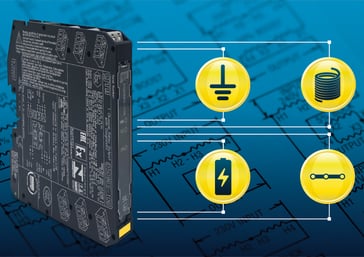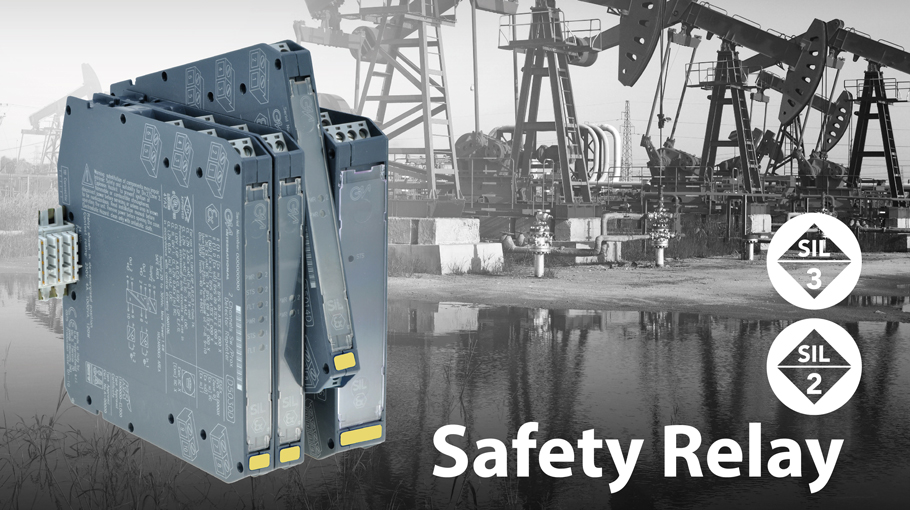Browsing through the realm of relays might be an overwhelming task since there are many different technologies and uses that can be associated with this device.
The term “relay” encompasses various families and an even higher number of usage scenarios. We can navigate through coaxial, stepping, vacuum, polarized relays utilized in the communication industry, as well as specialized latching relays for earth-leakage detection and power relays. However, the primary focus here is understanding what distinguishes a relay as a "safety relay". The number of relays has increased since the invention of the first electrolytic relay at the beginning of the 19th century, which was a part of the electro-chemical telegraph. It didn't take long before studies and engineering research resulted in a simple mechanism that acted as a digital amplifier, capable of repeating a signal from a telegraph. This successful concept opened new frontiers not only in the communication sector but also in many other fields. Year after year, relays have become a fundamental part of our everyday life. We can consider its early usage in the development of one of the first electro-mechanical computers, where relays were employed for logic and working registers. Although electronic components have proven to be faster and more convenient, the relay continues to play a fundamental role in this realm. As expected, some of the relays mentioned earlier are gradually phasing out, for newer and more sustainable alternatives. In this post, we will explore the periphery of what revolves around the sphere of safety relays.
What is a safety relay?
A safety relay can be defined as a piece of equipment, used in safety-critical applications, responsible for ensuring the secure operations of machinery and instruments. Therefore, a safety relay plays an active role when integrated into a safety instrumented function within a safety instrumented system. These devices, when properly introduced into an installation, can guarantee the safety of personnel, assets, and production operations. In the event of a hazardous occurrence, the role of a safety relay is to perform appropriate operations to reduce the risk or mitigate the consequences to an acceptable level. It is evident that there is much more to learn about what a safety relay is and the features that make it a safety-oriented device.

Differences between a standard and a safety relay
A standard relay is essentially an electromagnetic operated switch, consisting of a coil of wire winded up to an iron core, a yoke, and the iron armature collectively defined as the electromagnetic stone block. When activated by the electromagnetic force, the armature’s movement pushes the card, and consequentially, one or more movable contacts towards the fixed contact. This side of a standard relay is usually called contact block. Thus, a relay is made of two sides: the coil side and the contact side. This concept can still be considered valid when discussing about safety relay. While it is true that a safety relay, like a standard relay, has a coil side where the input command is wired, it diverges in its internal structure. A safety relay includes a set of additional contacts as output, along with other components that enhance its complexity while simultaneously ensuring reliability and security.
What is instinctively noteworthy is that a safety relay is not a single electromechanical element, but rather a combination of electronic circuitry that includes more than one electromechanical component. Consequently, the list of differences between a standard relay and a safety relay is extensive, encompassing aspects such as its safety function, related characteristics, the way it operates in the event of internal failure, and various other factors.
Why to use a safety relay
Safety relays are used to enhance safety in industrial and commercial applications by providing an additional layer of protection and control. They are purpose-built devices designed to monitor safety-related devices and implement safety functions in machinery, processes, and systems. Implementing a safety relay in any installation means to provide a robust, reliable fail-safe solution for driving, monitoring, and controlling the most delicate functions of a more complex system.
The reasons why to use a safety relay are embedded within each feature, and it is essential to leverage all of them.
Where to use a safety relay
Safety relays are primarily utilized in situations where ensuring the safety of delicate applications is crucial, especially when hazardous situations can escalate into significant risks. In practical terms, this involves safeguarding all parties involved in the application, whether they are human beings, assets, company properties, or the environment, to prevent a catastrophic outcome in perilous situations. To achieve these critical tasks, regulations and directives have been purposefully written by skilled specialists and enforced by the law. The direct impact of safety relays on our everyday lives is evident, even if not visible to the general public, in various industries. Notable examples include automotive, transportation, power distribution, machinery and automation, oil and gas, among many others.
The heritage left by numerous industrial tragedies has been the driving force for experts, insiders, pundits, and lawmakers to seek optimal solutions for accidents prevention. In every environment where a safety relay is employed, there is a specific safety related function which it is called to perform. In other words, a safety relay is used in cases where a controller (such as a digital output card of a PLC) is unable to activate a field device due to its limitations in handling voltage and current. In other scenarios, safety relays are essential for situations requiring multiple contacts for the simultaneous activation of multiple loads or in those applications where the safety function needs to be inverted. Safety relays can be integrated into safety control systems, safety PLCs, or safety-rated controllers to form comprehensive safety solutions for complex industrial applications.
When to use a safety relay
As a safety relay is an apparatus with the capability to perform a safety function, it must be employed whenever the circumstances demand protective measures for an installation. This aligns with the definition of functional safety, where there is an obligation to ensure design robustness to reduce, mitigate, and possibly eliminate any risk of dangerous conditions. Each safety instrumented system oversees a specific and well-defined part of the installation, and, within the same framework, each sub-system, known as a safety instrumented function, involves the use of safety relays. The general features of any safety relay are the main reason why these devices are the fundamental part of a risk reduction strategy.
When a safety relay is employed, it indicates a situation with little or no margin for error. Indeed, safety relays play a pivotal role in ensuring compliance with safety standards and regulations set forth by organizations such as ISO, IEC, and regional safety authorities. Using safety relays helps meet legal requirements and ensure a safe working environment. It is crucial to specify that these certified tools are also rated based on their safety performance, typically assessed using Safety Integrity Levels (SIL) or Performance Levels (PL). These ratings signify the reliability of the safety relay in preventing hazardous failures and meeting specific safety requirements, always certified by accredited bodies and organizations.
How to choose a safety relay
To ensure that a safety relay performs its safety functions without encountering setbacks throughout its lifespan, it is mandatory that it operates in an environment that suits its technical features. This is a process that should be conducted during the design stage, while it is always possible to modify the schematics without facing particular problems. Of course, in many circumstances, at least we should endeavor to compile a clear list of the key features that a safety relay must have to fit our application. Although recreating a real-life scenario on paper can be challenging, having a clear list is essential.
Considering only the contact rating, the input and output conditions, or the type of load is not sufficient. To select a safety relay, it is necessary to define all safety requirements and functions; the coil and contact conditions, the redundancy, and the environmental conditions must be considered. In addition to all of this information, before making any final decision, it can also be useful to contact the relay manufacturer and obtain firm confirmation of the choice. If you want to know more about this task, you can consider reading our guide about how to choose a safety relay, where it explains, step by step, how to proceed.
How to wire a safety relay
Safety relays are always part of a broader safety system, and their effectiveness relies on proper integration and implementation within the safety circuit. It is crucial to consult relevant safety standards and work with experts when designing, installing, and maintaining safety relay systems to ensure the safety of personnel and equipment. For this reason, proper wiring and installation are crucial factors for the reliable operation of safety relays.
Attention must be given to wire routing, grounding, and separation from other control circuits to prevent interference and ensure safety integrity. Incorrect wiring can lead to unpleasant circumstances, such as unwanted faults or spurious trips, which may impair the production process and result in financial losses. An unsuitable setup of the loops might also affect the device's life expectancy or even cause permanent and irreparable damage to the safety relay. There are some methods and precautions you should remember when wiring a safety relay as it is a delicate yet essential operation. Having a clear understating of the cabinet scenario is a great advantage in case a comprehensive troubleshooting procedure is required, because it is essential to avoid dwelling on restoring the normal plants condition.
Conclusions
In conclusion, a safety relay operates as a critical link in the safety chain of a machine or process. It evaluates safety inputs, applies predefined safety logic, and responds appropriately to prevent accidents and ensure a safe working environment. Its ability to detect hazardous conditions and execute safety functions plays a vital role in safeguarding personnel, protecting equipment, and meeting safety standards and regulations.


